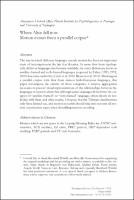Chapter Where Alice fell into
Motion events from a parallel corpus
Author(s)
Verkerk, Annemarie
Contributor(s)
Szmrecsanyi, Benedikt (editor)
Wälchli, Bernhard (editor)
Collection
European Research Council (ERC); EU collectionLanguage
EnglishAbstract
The way in which different languages encode motion has been an important topic of investigation in the last few decades. As more data from typologically different languages has become available, the strict dichotomy between satellite-framed and verb-framed languages proposed by Talmy (1985, 1991, 2000) has come under fire (Croft et al. 2010; Beavers et al. 2010). Drawing on a parallel corpus with data from sixteen Indo-European languages, this paper investigates the validity of these categories. I employ aggregation measures to present visual representations of the relationships between the languages in order to show that although some languages fit well into the category of “satellite-framed” or “verb-framed” language, others clearly do not. In line with these and other results, I propose that the Talmyan classifications only have limited use, and motion research should take into account all motion construction types when describing motion encoding.
Book
Aggregating Dialectology, Typology, and Register Analysis: Linguistic Variation in Text and SpeechKeywords
Variation; dialectology; linguistic typologyDOI
10.1515/9783110317558.324ISBN
9783110317398; 9783110372540OCN
1135847588Publisher
De GruyterPublisher website
https://www.degruyter.com/Publication date and place
Berlin/Boston, 2014Grantor
Classification
Linguistics
Sociolinguistics
Dialect, slang and jargon
Computational and corpus linguistics


 Download
Download